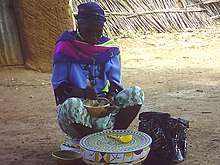Fura (food)
Fura are millet dough balls eaten in Nigeria, Niger and Ghana.[1][2][3]Fura da nono originates from the Fulani people of West Africa. It is a locally made drink prepared from a combination of fermented milk and ground millet grains. Sugar is added to the mixture to give it taste. It contains carbohydrate and fiber[4]
 A Fulani woman preparing fura da nono. | |
| Course | Snack |
|---|---|
| Place of origin | Ghana |
| Serving temperature | Cold |
| Main ingredients | Millet, Dry Ginger, Cloves, Dry Chilli Pepper. |
References
- Telling Stories, Making Histories - Page 66 Certainly, the making of the classic dish, fura da nono (seasoned, boiled millet balls served with sour milk), represents such a blending of food resources and styles of cuisine. This suggests that a transfer of the cuisine of fura served with sour ...
- African Farming and Food Processing 2005 Fura is a staple food for both Fulanis and Hausas. Wherever there is a settlement of these tribes, fura, kindrimo and nono are marketed. A number 3f the dealers of fura are women between 25 to 35 years of age without formal education.
- www.ghanafoodnetwork.net http://www.ghanafoodnetwork.net/recipe/fura-fula-millet-smoothie/. Retrieved 2020-06-13. Missing or empty
|title=(help) - "Fura da Nono: Save yourself some money, learn how to make millet cereal". www.puls.ng.
- Joseph, J. K.; Belewu, M. A.; Omotuyi, O. J. (1998-01-01). "Acceptability and effect of mixing ratios on the quality attributes of 'Fura-de-Nono': A Nigerian milk product". Food Quality and Preference. 9 (1): 1–4. doi:10.1016/S0950-3293(97)00011-6. ISSN 0950-3293.
- Atanda, O. O.; Ikenebomeh, M. J. (1988). "Changes in the acidity and lactic acid content of 'Nono', a Nigerian cultured milk product". Letters in Applied Microbiology. 6 (6): 137–138. doi:10.1111/j.1472-765X.1988.tb01233.x. ISSN 1472-765X.
- Adebesin, A. A.; Amusa, N. A.; Fagade, S. O. (2001-03-01). "Microbiological quality of locally fermented milk (nono) and fermented milk-cereal mixture (fura da nono) drink in Bauchi, a Nigerian city". Journal of Food Technology in Africa. 6 (3). doi:10.4314/jfta.v6i3.19295. hdl:1807/2964. ISSN 1028-6098.
This article is issued from Wikipedia. The text is licensed under Creative Commons - Attribution - Sharealike. Additional terms may apply for the media files.